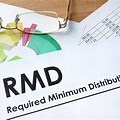
Rules change with time, and the required minimum distributions (RMDs) rules have changed. RMDs are retirement accounts, i.e., traditional IRAs and 401(k) plans). The new government has imposed new regulations on how American retirement accounts operate. Someone approaching retirement or saving for retirement should stay updated on these rules to have successful financial plans for retirement. There are some changes to the course:
The President mandates you to start withdrawing from your retirement accounts but not Roth IRAs. However, the law was supposed to affect people over 72, but the new law, Secure 2.0, shifts it to 75. The law has two ways of running the age verification:
The age shifts from 72 to 73 at the start of 2023.
The age creeps up to 75 as of 2033.
The penalty for not withdrawing from your RMD is a 50% excise tax on the remaining distributions in the account. These penalties attach to you if you don't make the minimum required withdrawal or try to bypass the RMD. However, you may avoid the penalties if you have a genuine excuse like illness, but you must withdraw the maximum amount speedily. You file the penalty waiver using Form 5329.
Furthermore, the 50% tax is hefty, which is why Secure 2.0 amended it to 25%. Plus, you can reduce the penalty to 10% if you withdraw before the second-year ends. However, the waiver law starts in 2023.
The RMDs law does not affect Roth IRAs except Roth 401(k). Therefore, you can bend the law by transferring your money to a Roth IRA account. However, the Roth IRA five-year rule hinders the rolling over of IRA money. The new regulation removes the need to roll over money to a Roth IRA, preventing the law from affecting Roth 401(k) before the account holder's death. After death, post-death minimum distribution rules apply but start in 2024. Accounts that are privileged for exemptions will still not receive payment until January 1, 2021, or later.
An annuity account is divided into two parts – the annuity holder and the other for RMD rules. The affected portion attracts higher RMDs. But you can merge both accounts under the Secure 2.0 Act. In addition, it also allows the annuitant to enjoy certain privileges like;
Accounts with an annual increase of 5%.
Lump sum transactions that result in a delay in annuity payment or partial commutation affecting future payments.
Lump sum transactions that result in speedy annuity payments within 12 months.
Dividend or similar distribution payments.
Death benefit payment but not above the annuity amount, minus the average sum before distribution or other payments concerning the contract.
However, the new Secure 2.0 Act increases the qualifying longevity annuity contracts (QLACs). The QLACs receive up to $130,000 as of 2022, or 25% of the total retirement fund. However, the law protects the lower amount from RMDs by removing the 25% limit and increasing the sum to $200,000. In addition, you can receive survival benefits of divorce, and an employee must rescind a QLAC within 90 days.
Donating to charity through a qualified charitable distribution (QCD) boosts your RMD. So, donate to charity to beat the minimum withdrawal law, but it must not be more than $100,000 per year. The $100,000 limit in the Secure 2.0 Act can be adjusted according to annual inflation by rounding up to the nearest $1,000.
The adjustment started in 2021. But you are allowed to make $50,000 to charities in 2023 through approved charitable annuity trusts, charitable remainder trusts, and charitable gift annuities.
FOR MORE INFORMATION ON HOW ROSOVICH & ASSOCIATES, INC. CAN BEST HELP YOU WITH YOUR TAX FILING NEEDS, PLEASE CLICK THE BLUE TAB ON THIS PAGE.
THANKS FOR VISITING.
Rosovich & Associates, Inc.